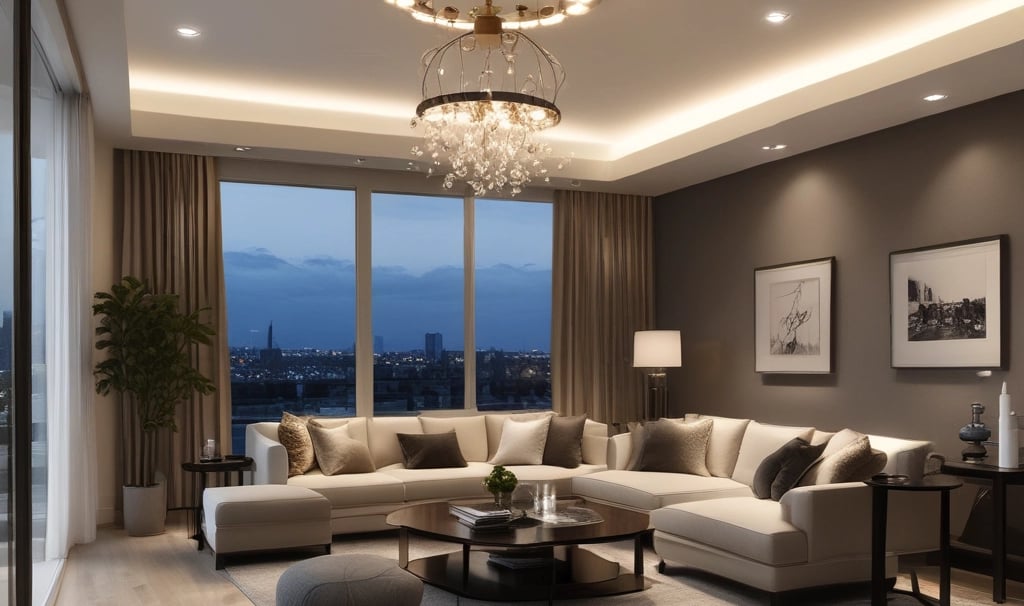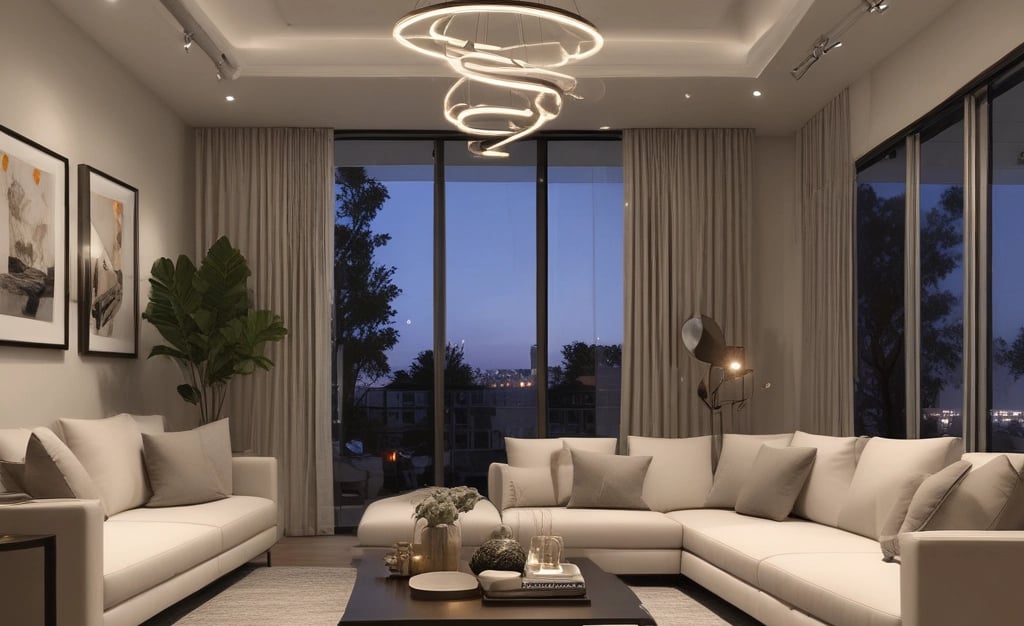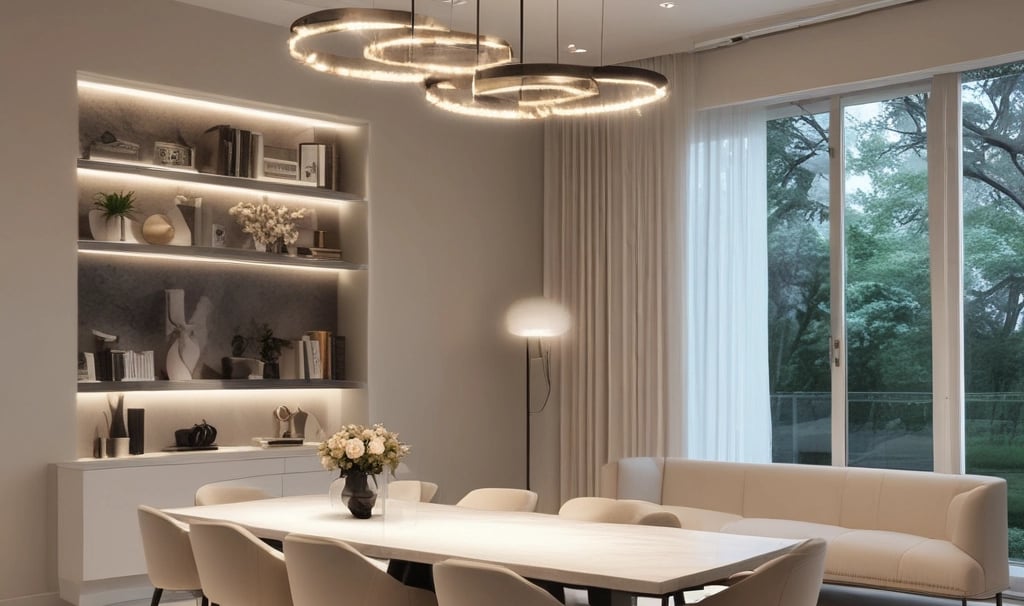Mastering Lighting Design in Home Interiors
HOME DESIGN IDEAS
Mohamed Amine
10/21/20258 min read


Introduction to Lighting Design
Lighting design is a pivotal component in the realm of home interiors, serving a dual purpose of functionality and aesthetic appeal. At its core, effective lighting enhances the usability of a space while also shaping the overall atmosphere and mood. Homeowners and designers alike must appreciate that lighting is not solely about illuminating a room; it is about creating an experience and guiding the perception of space.
The importance of lighting design extends beyond just providing visibility. It incorporates various elements such as the type of fixtures used, their placement within a room, and the quality of light they emit. For instance, ambient lighting creates a general illumination that makes a space feel welcoming, while task lighting focuses light on specific areas to facilitate activities like reading or cooking. Accent lighting, on the other hand, is employed to highlight decor pieces or architectural features, adding depth and dimension to the interior aesthetic.
Furthermore, the appropriate use of lighting can significantly affect emotions and behaviors. Warm light may evoke feelings of comfort and relaxation, making it ideal for living rooms and bedrooms, while cooler light can improve concentration and productivity, making it suitable for workspaces. This strategic use of lighting is therefore essential in shaping how inhabitants interact with their environment.
As we delve further into the nuances of lighting design, it is vital to recognize it as an integral part of interior decoration. By understanding and harnessing the various ways in which light can influence a space, one can effectively craft interiors that are not only beautiful but also resonate emotionally with the occupants. Embracing this approach allows for a more holistic view of home interiors, ultimately leading to more cohesive and dynamic living environments.
Understanding the Importance of Lighting as a Key Element
Lighting is a fundamental component of interior design that significantly affects the overall aesthetic and functionality of a space. Its importance cannot be overstated, as it has the power to transform environments, create ambiance, and showcase architectural features. Through appropriate lighting design, homeowners can foster a space that not only caters to their needs but also enhances their well-being and lifestyle.
One of the primary effects of lighting is its ability to evoke emotions. Warm, soft lighting can impart a sense of comfort and relaxation, making a living area feel inviting and cozy. In contrast, bright, cooler lighting may be more stimulating, promoting alertness and concentration, which is particularly beneficial in workspaces. Understanding these psychological ramifications allows designers to implement lighting solutions that are aligned with the intended use of each room, whether it is for entertainment, work, or rest.
Furthermore, effective lighting highlights architectural elements, adding depth and character to interior spaces. By strategically placing light fixtures, such as recessed lighting or accent lights, one can draw attention to artwork, textured walls, or unique architectural designs. This not only elevates the aesthetic appeal but also enriches the overall visual experience within the home.
Different lifestyles and daily activities necessitate distinct lighting needs. For example, a home that emphasizes relaxation may benefit from ambient lighting combined with task lighting for specific areas, such as reading nooks or kitchen counters. Conversely, a bustling family home may require versatile lighting solutions that can adapt to various activities throughout the day. By addressing these varying requirements, it becomes clear that lighting design is an essential element that intersects with the functionality and character of living spaces.
The Role of Lighting in Interior Aesthetics
Lighting plays a pivotal role in enhancing the aesthetic appeal of home interiors, influencing both the ambiance and functionality of spaces. Effective lighting design not only illuminates but also enhances the overall mood and character of a room. Different lighting techniques such as ambient, task, and accent lighting contribute uniquely to the interior aesthetics across various areas of a home.
In the living room, for example, ambient lighting serves to create a warm and inviting environment, often achieved through chandeliers or recessed lights that provide a balanced glow. Complementing this ambient layer with task lighting, such as reading lamps or wall sconces, allows for functionality without sacrificing style. Accent lighting, on the other hand, can draw attention to artwork or architectural features, enriching the visual interest of the space and creating depth through contrasts of light and shadow.
The kitchen, traditionally a vibrant and functional area, benefits from layered lighting as well. Bright overhead fixtures ensure practical illumination for cooking, while under-cabinet lighting adds a decorative touch and increases visibility on work surfaces. This duality not only enhances the kitchen's functionality but also contributes significantly to its aesthetic charm, promoting a lively culinary environment.
Bedrooms call for a different approach to lighting, often emphasizing relaxation and tranquility. Soft, diffused light from bedside lamps or dimmable fixtures invites a peaceful atmosphere, facilitating unwinding after a long day. By incorporating various light sources, including pendant lights or wall-mounted fixtures, homeowners can achieve a dynamic space that maintains an intimate feel.
Through case studies and visual examples, the transformative power of lighting in shaping interior aesthetics becomes clear. Thoughtfully designed lighting solutions can create distinct atmospheres, enhance architectural features, and ultimately elevate the everyday experience within different areas of the home. The integration of lighting design into interior space planning is essential for those looking to master the art of interior aesthetics.
Types of Interior Lighting
Lighting design plays a crucial role in enhancing the ambiance and functionality of home interiors. There are three primary types of interior lighting that work together to create a cohesive atmosphere: ambient, task, and accent lighting. Understanding the distinct functions of these three categories can help homeowners achieve the desired design harmony in their spaces.
Firstly, ambient lighting serves as the general illumination in a room, providing a uniform level of light throughout the space. It is essential for ensuring safety and comfort, allowing individuals to navigate through areas effortlessly. Common sources of ambient lighting include ceiling-mounted fixtures, chandeliers, and recessed lighting. By choosing the appropriate brightness levels and fixtures, homeowners can establish a welcoming environment while also adding aesthetic appeal to their interiors.
Next, task lighting is specifically designed to illuminate areas where activities that require focused light take place. This includes reading, cooking, or even working at a desk. Task lighting can be achieved through table lamps, under-cabinet lighting in kitchens, and wall-mounted sconces in offices or study areas. When incorporating task lighting, it is crucial to consider both the functionality and style, ensuring that these lighting sources complement the overall decor of the space.
Lastly, accent lighting adds an artistic touch by highlighting specific features such as artwork, architectural details, or plants. This type of lighting is generally more concentrated and can create focal points within a room. Examples of accent lighting include track lights, spotlights, and decorative wall sconces. By strategically placing these lighting elements, homeowners can draw attention to the unique aspects of their interiors while enhancing the visual interest of the space.
In summary, a well-balanced lighting design incorporates ambient, task, and accent lighting to create a harmonious living environment. By understanding the characteristics and purposes of these lighting types, homeowners can make informed choices that elevate their home interiors while providing both functionality and aesthetic appeal.
Natural vs. Artificial Lighting
Lighting design plays a crucial role in enhancing the aesthetic and functional aspects of home interiors. Among the primary sources of lighting are natural light and artificial light, each with its unique advantages and limitations. Natural light, which is derived from sunlight, offers the benefit of being free and abundant during daylight hours. It has been shown to positively impact mood and productivity, creating a warm and inviting atmosphere. Rooms that are well-lit by natural light often feel more spacious and airy, as light reflects off walls and surfaces, enhancing the perception of space. Strategic placement of windows and the use of reflective materials can significantly maximize the entrance of natural light into a room.
However, it is essential to recognize the limitations of relying solely on natural light. Availability fluctuates throughout the day and across seasons, resulting in dim interior environments, especially during overcast conditions or at night. Therefore, it is vital to integrate artificial lighting solutions to maintain a comfortable and vibrant space at all times. Artificial lighting sources, such as ceiling fixtures, lamps, and wall sconces, can be tailored to various activities and moods. They offer flexibility in managing light levels, color temperatures, and energy efficiency, allowing homeowners to create a dynamic ambiance that meets their specific needs.
To achieve a well-balanced lighting design, combining both natural and artificial lighting is recommended. This integrated approach ensures that interiors are not only visually appealing but also functional at all hours. Homeowners can optimize their spaces by layering different types of artificial lighting, such as ambient, task, and accent lighting, to complement natural light during the day and provide enough illumination after sunset. Overall, understanding the interplay between natural and artificial lighting is essential for mastering lighting design in home interiors, helping create environments that are comfortable, welcoming, and aesthetically pleasing.
Lighting Techniques for Different Spaces
Effective lighting design plays a crucial role in enhancing the functionality, ambiance, and aesthetics of various spaces within a home. Each room requires tailored lighting approaches to meet its unique demands, ensuring both practicality and style are upheld. When considering lighting options, it is essential to identify the specific needs of each space.
In living areas, the objective is often to create a warm and inviting atmosphere. Layering different types of lighting, such as ambient, task, and accent lighting, is advisable. For ambient lighting, overhead fixtures or chandeliers can provide general illumination. Incorporating table lamps and floor lamps contributes to task lighting, enabling activities such as reading or socializing. To elevate aesthetics, consider using recessed lighting or wall sconces to highlight artwork or architectural features.
For kitchens, the emphasis shifts to functionality and safety. Bright and direct ambient lighting is crucial, typically achieved with ceiling-mounted fixtures. Task lighting beneath cabinets serves to illuminate work surfaces effectively while reducing shadows. Accent lighting can add character; pendant lights over islands or dining areas can serve both practical and decorative purposes, making the space feel warm and welcoming.
In bedrooms, establishing a calming retreat is paramount. Soft ambient lighting is often ideal, provided by ceiling fixtures or dimmable wall lights. Bedside lamps also contribute to personalized task lighting, allowing for reading without disrupting the overall ambiance. To instill a sense of tranquility, consider using warmer color temperatures in lighting schemes, which can help to foster relaxation.
Finally, bathrooms demand versatile lighting solutions. Bright, even lighting is important for grooming tasks; using a combination of overhead lighting and side-mounted fixtures near mirrors can successfully minimize shadows. Ambient lighting should still be soft to create a soothing atmosphere, while accent features, such as backlit mirrors, can add a stylish touch to this essential space.
Conclusion and Final Thoughts
Effective lighting design is a fundamental aspect of home interiors that often goes unnoticed, yet it holds the power to transform spaces significantly. Throughout this discussion, we have examined the various types of lighting ambient, task, and accent that contribute to creating layered environments. Each of these lighting forms plays a distinct role, and their thoughtful integration can lead to improved functionality and aesthetic appeal within any room. By understanding the purpose of each lighting type, homeowners can tailor their designs to suit their specific needs and preferences.
Moreover, we highlighted the importance of considering natural light. Strategically positioned windows and reflective surfaces not only amplify brightness but also enhance the mood and energy of the space. Harnessing the benefits of natural light can lead to healthier and more inviting interiors, creating a harmonious balance between indoor and outdoor elements. The combination of artificial and natural lighting serves to elevate the overall atmosphere of a home.
In addition, the use of smart lighting technologies has emerged as a significant trend in contemporary home design. These innovations allow homeowners to customize their lighting experiences with ease, adjusting brightness levels and color temperatures to match their activities or moods. Such advancements underscore the importance of adaptability within lighting design, urging individuals to think critically about their environments and how lighting can augment their experiences.
As you reflect on your own living spaces, consider the insights shared in this article. Take the time to evaluate your current lighting solutions and explore how adjustments can lead to a more visually appealing and comfortable home. Thoughtful lighting design not only enhances aesthetic elements but also influences well-being and functionality. Investing in this aspect of interior design can result in a vastly improved quality of life at home.
References
Residential Lighting: A Practical Guide to Beautiful and Sustainable Lighting Design
Author: by Randall Whitehead
Link: Residential LightingLighting Design Basics
Author: by Mark Karlen & James Benya
Link: Lighting Design BasicsThe Art of Illumination: Residential Lighting Design
Author: by Randall Whitehead
Link: The Art of IlluminationInterior Lighting for Designers
Author: by Gary Gordon
Link: Interior Lighting for Designers




